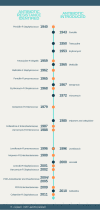The Phenomenon of Antibiotic Resistance in the Polar Regions: An Overview of the Global Problem
- PMID: 37034396
- PMCID: PMC10081531
- DOI: 10.2147/IDR.S369023
The Phenomenon of Antibiotic Resistance in the Polar Regions: An Overview of the Global Problem
Abstract
The increasing prevalence of antibiotic resistance is a global problem in human and animal health. This leads to a reduction in the therapeutic effectiveness of the measures used so far and to the limitation of treatment options, which may pose a threat to human health and life. The problem of phenomenon of antibiotic resistance affects more and more the polar regions. This is due to the increase in tourist traffic and the number of people staying at research stations, unmodernised sewage systems in inhabited areas, as well as the migration of animals or the movement of microplastics, which may contain resistant bacteria. Research shows that the presence of antibiotic resistance genes is more dominant in zones of human and wildlife influence than in remote areas. In a polluted environment, there is evidence of a direct correlation between human activity and the spread and survival of antibiotic-resistant bacteria. Attention should be paid to the presence of resistance to synthetic and semi-synthetic antibiotics in the polar regions, which is likely to be correlated with human presence and activity, and possible steps to be taken. We need to understand many more aspects of this, such as bacterial epigenetics and environmental stress, in order to develop effective strategies for minimizing the spread of antibiotic resistance genes. Studying the diversity and abundance of antibiotic resistance genes in regions with less anthropogenic activity could provide insight into the diversity of primary genes and explain the historical evolution of antibiotic resistance.
Keywords: Antarctica; Arctic; antibiotic resistance; bacteria; bacterial community and diversity; polar regions.
© 2023 Depta and Niedźwiedzka-Rystwej.
Conflict of interest statement
The authors report no conflicts of interest in this work.
Figures
References
Publication types
LinkOut - more resources
Full Text Sources



